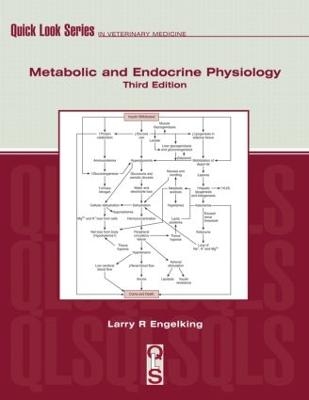
Metabolic and Endocrine Physiology
Teton NewMedia (Verlag)
978-1-59161-046-5 (ISBN)
This book is intended to give readers a “quick look” at metabolic and endocrine physiology. Emphasis is placed on instructional figures, flow diagrams and tables, while text material has been held to a minimum. In general, the endocrine system is first defined and described, and then each endocrine gland is discussed separately. Where appropriate, common endocrine disorders have also been included. This text concisely elucidates the endocrine mechanisms responsible for maintaining homeostatic control of important physiologic variables, and to assist the reader in understanding common pathophysiologic deviations from normal. Over 360 multiple-choice questions gauge the reader’s capacity to effectively understand the subject material.
This new edition contains six new chapters covering: hormone disposition, measurement and secretion; bovine, equine and rodent estrus cycles; primate menstrual cycle; male reproductive system; testosterone, estrogen and progesterone; comparative aspects of endocrinology. Learning objectives have been added at the beginning of each chapter and all of the questions are new.
Larry Engelking
ContentsChapter 1. Endocrine System (Overview)Chapter 2. Endocrine Secretory Control (Autocrine, Paracrine, and Endocrine Mediators)Chapter 3. Hormone Disposition, Measurement and Secretion (Production & Distribution Volume, Clearance & Immunoassay)Chapter 4. Mechanisms of Catecholamine and Polypeptide Hormone Action: I (Receptors and Second Messengers)Chapter 5. Mechanisms of Catecholamine and Polypeptide Hormone Action: II (The Intracellular Ca2+/DG Messenger System)Chapter 6. Steroid and Thyroid Hormones (Mechanisms of Action)Chapter 7. Hypothalamus and Pituitary (Directors of the Endocrine Orchestra)Chapter 8. Proopiomelanocortin and Related Peptides: I (Endogenous Opiate-Like Peptides)Chapter 9. Proopiomelanocortin and Related Peptides: II (Melanocyte-Stimulating Hormone)Chapter 10. Growth Hormone: I (Actions and Secretory Control)Chapter 11. Growth Hormone: II (Hypo- and Hypersomatotropism)Chapter 12. Antidiuretic Hormone (Vasopressin)Chapter 13. Diabetes Insipidus (Central and Nephrogenic)Chapter 14. Calcium (Physiologic Actions)Chapter 15. Magnesium and phosphate (Physiologic Actions)Chapter 16. Parathormone, Calcitonin, and Vitamin D: I (PTH, PTHrp, and CT)Chapter 17. Parathormone, Calcitonin, and Vitamin D: II (CT and 1,25(OH)2D)Chapter 18. Disorders of Calcium Homeostasis (Hyper- and Hypocalcemia)Chapter 19. Mineral Imbalances: I (Na+, K+, PO43-, and Mg2+)Chapter 20. Mineral Imbalances: II (Parturient Hypocalcemia and Osteoporosis)Chapter 21. ACTH and Glucocorticoids: I (Corticosteroidogenesis and Degradation)Chapter 22. ACTH and Glucocorticoids: II (ACTH Secretion and Action)Chapter 23. ACTH and Glucocorticoids: III (Organ and Tissue Effects)Chapter 24. ACTH and Glucocorticoids: IV (Physiologic and Pharmacologic Actions)Chapter 25. Cushing's-Like Syndrome and Disease (Glucocorticoid Excess)Chapt
| Reihe/Serie | Quick Look Series |
|---|---|
| Verlagsort | Jackson |
| Sprache | englisch |
| Maße | 210 x 280 mm |
| Gewicht | 748 g |
| Themenwelt | Naturwissenschaften ► Biologie ► Zoologie |
| Veterinärmedizin | |
| Weitere Fachgebiete ► Land- / Forstwirtschaft / Fischerei | |
| ISBN-10 | 1-59161-046-X / 159161046X |
| ISBN-13 | 978-1-59161-046-5 / 9781591610465 |
| Zustand | Neuware |
| Informationen gemäß Produktsicherheitsverordnung (GPSR) | |
| Haben Sie eine Frage zum Produkt? |
aus dem Bereich


